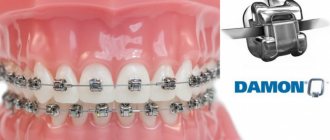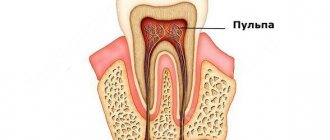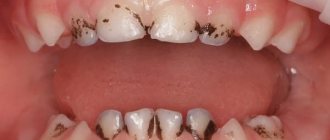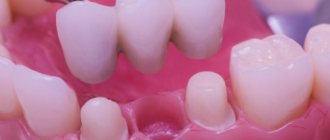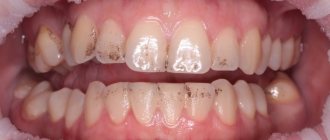Regular care of removable dentures is a necessary measure to maintain a clean oral cavity. After eating, bacterial plaque forms on teeth and orthopedic structures, which causes bad breath and can provoke gum inflammation. To avoid unnecessary problems, you should take care of your dentures daily. Maintaining hygiene will extend their life, prevent the development of dental diseases and help maintain an attractive smile.
Hygienic products for denture care
Caring for orthopedic structures does not take much time. Dentures can be removed, cleaned of dental plaque and rinsed under water after eating. For cleaning, many products are used that help get rid of pigmented plaque and remove harmful microflora.
Toothbrush
For everyday hygiene, use a personal brush with soft bristles. Too hard villi can scratch the surface of the prosthesis, and bacteria will accumulate in microscopic cracks. Cleaning should be done twice a day. Instead of a regular brush, you can use a special double-sided brush, which is designed for caring for orthopedic structures. On one side there is a long working surface, which is designed to clean the outer surface of the product. On the inside there is a short part with rounded bristles that clean the inner surface of the prosthesis well.
Toothpaste
To clean orthopedic devices, it is recommended to use low-abrasive toothpaste. As with the brush, if you use products with a high abrasive content, this can lead to damage to the surface of the structure. Children's toothpastes are considered the most gentle. They gently clean teeth and provide gentle care for dentures. You can also use a therapeutic and prophylactic paste, which contains plant components with an antibacterial effect.
Tooth brush
Standard denture care products can be supplemented with a dental brush, which helps remove dirt from the interdental spaces. Unlike a toothbrush, it has finer bristles that can penetrate even hard-to-reach places. Brushes vary in shape, size, and density of bristles. The vector and principle of their movement during cleansing is similar to a toothpick, however, they are reusable and require washing after the procedure.
Rinse aid
Rinses include special liquids that disinfect the oral cavity and prevent the development of inflammation. They can be used after every meal or sugary drink. During the care process, they clean dentures from food debris, prevent the formation of tartar and freshen breath. Consumers are offered a wide selection of rinses for various purposes:
- anti-caries;
- anti-inflammatory;
- whitening;
- for sensitive gums and teeth;
- combined.
When wearing removable dentures, it is advisable to select products that contain antimicrobial components and prevent the proliferation of pathogenic microorganisms.
Floss
Floss, or dental floss, is used to clean the interdental spaces and the area near the gums. It is made from polymer or natural fibers and comes in small rolls. To clean, you need to cut a small piece of thread, insert it into the gap between the crowns and move it up and down. Regular use of floss helps eliminate plaque, eliminates unpleasant odor, and prevents the creation of a favorable environment for the proliferation of microorganisms.
Irrigator
An irrigator is a device for oral hygiene that performs cleaning by supplying a jet of water under pressure. It can be used to clean both natural teeth and removable orthopedic structures. Most irrigators have two operating modes (“jet” or “shower”), which are selected according to the desired effect. Thus, the “shower” provides general cleaning of the oral cavity and at the same time performs hydromassage of the gums, and the “jet” is used to remove plaque from the interdental space, in the cervical area and other hard-to-reach places.
Citric acid and soda, tablets for cleaning and disinfection
All of the above products are suitable for periodic oral hygiene and removable dentures. They are used as aqueous solutions in which structures are placed for some time. They can also be used as a mouth rinse. Thanks to their antibacterial effect, they effectively remove bacteria and help prevent inflammatory processes. The solution is prepared depending on the chosen product. So, when using citric acid, take one teaspoon of powder and mix with 150 ml of boiled water. The average time for soaking dentures in this solution is 10 minutes.
Cleaning process
To clean the structure, you can use a regular brush, paste and irrigator.
- Toothpastes a minimal amount or complete absence of abrasive elements and aseptic properties. The paste is applied to the prosthesis, foamed with a special brush for 1 minute, followed by cleansing and rinsing with running water.
- Express foams, with which you can quickly and effectively remove dirt and get rid of microorganisms. It is advisable to use a soft nylon toothbrush for this.
- Effervescent tablets that deeply clean clasp dentures, protecting against the development of stones, stains, and unpleasant odors. After dissolution, the structure should be in such water for about 15 minutes, however, this method is not suitable for long-term use, as it risks the formation of a porous surface of the product.
- Concentrates made from fruit acids. Easily destroy mineral deposits without damaging the prosthesis.
Materials for dental prosthetics
In orthopedic dentistry, many different materials are used to make removable and non-removable structures.
To protect the structure from breakage and destruction, fixing substances are used:
- Powders applied in a thin layer by spraying. They are advisable to use when there is decreased salivation.
- Creams, gels that provide tight fixation, preventing food from penetrating into the area between the base of the product and the mucous membrane. .
- Pads that reduce discomfort while getting used to a removable device.
To prevent inflammatory processes and destruction of the plastic prosthesis on hooks, after each meal, the structure should be removed and washed with water. As an alternative, it is recommended to rinse the mouth with an antiseptic balm.
Why can our articles be trusted?
We make health information clear, accessible and relevant.
- All articles are checked by practicing doctors.
- We take scientific literature and the latest research as a basis.
- We publish detailed articles that answer all questions.
Morning cleaning should be done before putting on the product, while evening cleaning should be done after taking it off. Properly clean dentures like natural teeth, using vertical movements. The most careful treatment is to treat the inside of the device, where bacterial deposits often accumulate.
Dentures with suction cups
Modern dentistry has come a long way in recent decades.
Only special tools will help completely remove plaque and microorganisms:
- Regular brushes. To clean hard-to-reach areas, use a device with soft bristles and uneven surfaces.
- Combined brushes combining classic and vertical tools. The second type is designed for convenient cleaning of the inside of the mechanism.
- Specialized brushes that effectively treat the area between the hooks of the prosthesis.
- Dental floss to be used after every meal.
Ultrasonic sanitation is used as an additional cleaning method. This bath means placing the prosthesis in a special small container with water. After turning on the device, high-frequency waves remove plaque from dentures and hooks and get rid of bacteria.
At the same time, ultrasound does not have a destructive effect on plastic, so the procedure can be carried out daily. However, ultrasonic baths cannot replace brushing with paste, so this method should be combined with other methods of removing dirt.
How to properly clean dentures
Removable dentures require regular cleaning. All rules for their hygiene can be divided into two categories - daily and periodic.
Daily
Daily care includes brushing your teeth in the morning and evening with a soft toothbrush. When cleaning, special attention is paid to the inside of the structure, which is in constant contact with the gums. After eating, the structure should be removed and rinsed under water. Additionally, you can use an irrigator, which thoroughly cleans surfaces and allows you to remove bacterial plaque in hard-to-reach places. When cleaning, care should be taken not to damage the locks, hooks and other elements of the orthopedic structure.
Periodically
Proper care of dentures does not just mean cleaning them from deposits with a brush and irrigator, but also using bactericidal solutions aimed at destroying pathogens. They are used up to three times a week according to the manufacturer's instructions. Additionally, it is recommended to use agents that inhibit bacterial activity. This is especially true several years after the installation of structures, since by this time more deposits have accumulated on them. These products include sprays and lozenges, which not only help fight pathogenic microflora, but also freshen breath and prevent inflammatory processes.
Methods for cleaning removable dentures at home: the best way to clean
There are two main options - physical and chemical. The first can be further divided into subclasses:
- ultrasonic;
- mechanical;
- temperature.
With an independent, as well as a professional approach, an integrated method is usually used, that is, exposure to several techniques to obtain a better result. It is worth considering some of them in detail to understand what we are talking about.
Cleaning and whitening at home
It is optimal to use all available resources, which can easily be purchased at a pharmacy or specialty store. It is quite possible to buy special brushes, tablets and even ultrasonic devices and use them regularly.
- The composition with active oxidizing agents allows us to talk about discoloration of pigmentation and the return of the product to its original shade.
- Relatively good whitening is provided by baths, since ultrasonic waves cause all impurities to peel off.
It is extremely important to understand that the use of inappropriate substances and reagents to achieve a snow-white effect is not only unproductive, but can also lead to serious consequences. Under no circumstances should potassium permanganate, bleach with or without chlorine, soda with vinegar or lemon juice, or other folk remedies be used. They can cause not only damage to the artificial teeth themselves, but also burns to the mucous membranes and even serious poisoning.
Which brush to clean dentures at home: how to proceed correctly
It is possible to achieve a high-quality whitening effect using such a device only if there are no stubborn, serious contaminants on the surface. Usually they hold it in their right hand, carrying out sweeping and/or polishing movements, after applying a little special paste or gel. Rinse everything with clean running water until it stops stained and soapy.
In all other cases, the brush will not help, even if you choose a fairly hard bristle. However, with frequent mechanical impact, noticeable scratches remain on some materials, and over time they lose their attractive appearance and require replacement.
Therefore, it is optimal to choose a brush that is intended just for such purposes. Regarding its choice, you need to talk with a hygienist or orthopedist from Dentics, who has complete information on the issue and will definitely give practical advice.
Disinfection of the prosthesis
From time to time, dentures should be disinfected, which will clean the surface of harmful bacteria. You can do this in two ways:
- Using disinfectants - special effervescent tablets that are pre-dissolved in water. Such preparations contain substances that help dissolve dental plaque, destroy bacteria and additionally whiten structures. When using tablets, just put the prosthesis in the prepared solution and wait 3 minutes. If necessary, at the end of the procedure, you can use a toothbrush and remove any remaining plaque manually.
- In an ultrasonic bath, the device helps remove bacterial plaque, get rid of unpleasant odors and destroy up to 100% of pathogens. The bath is more expensive than disinfectants, but you can buy it once and no longer spend money on purchasing chemicals.
Rules for storing removable dentures
One of the main rules of wearing removable dentures is that they must be removed at night. It is not advisable to sleep with them, since during sleep there is a possibility of their premature deformation. To store structures, it is better to use a special container that is equipped with a hermetically sealed lid. The protective box must be clean, dry and placed in a place inaccessible to children or pets. If the prosthesis is removed for a long time, it should be placed in a container with a disinfectant solution.
If you follow the recommendations for caring for removable dentures, you can significantly extend their lifespan. Proper oral hygiene will increase the comfort in using orthopedic structures and minimize the risks of complications when wearing them.
What not to do with a plastic prosthesis
Some people, due to ignorance and a desire to refresh the appearance of the orthopedic structure, make mistakes when caring for it. As a result of incorrect actions, you can get the opposite effect. To prevent this, when caring for a prosthesis you cannot:
- use sharp objects to remove food debris from various recesses and protrusions of the structure;
- soak the denture in vinegar, hoping to refresh and lighten its colors;
- use bleaches to clean artificial teeth, retainers and bases;
- use potassium permanganate, furatsilin and other coloring antiseptic agents for disinfection;
- store the product in chlorinated water, especially if there are metal parts;
- Avoid prolonged exposure of the prosthesis to direct sunlight.
If you follow these simple recommendations, the design will maintain a neat appearance throughout its entire lifespan.

